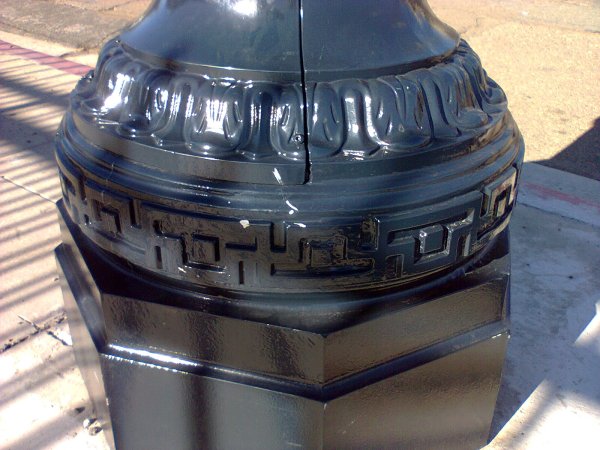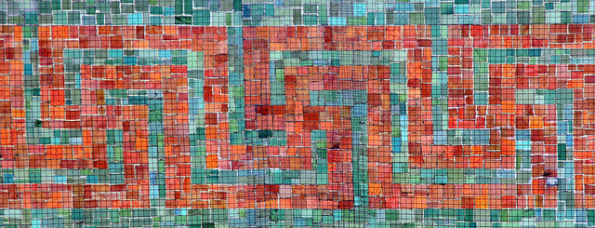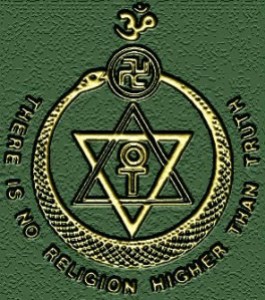Some of San Diego’s old antique gaslamps as in photo below have a pre-Nazi, swastika design on their base. Not sure how old these now electric, cast-iron lamps are, but it is probably a very safe guess that they were installed before the Nazi period. The swastika is a symbol of Buddhism and you will find this type of design on many Buddhist temples in Asia, as well as on Nazi buildings during the Nazi era. You can also see swastika designs in such places as Freemasonic lodges and Greek/Roman mosaics. There is nothing sinister about these particular gaslamps. Many people use swastikas a hundred years ago, before the Nazis made the symbol. I am not proposing that these gaslamps be eliminated. It is just an opportunity to present something interesting about San Diego history.

The Swastika was a widely used symbol, popularized in the West by the occult Theosophical Society, before it was chosen by Hitler as the logo of Nazism. The swastika is a very ancient symbol and represents fire or the sun in Hindu theology and is the symbol of the god, Agni, the acceptor of sacrifices and the inter-mediator with the gods. “Fire” represents destruction, transformation and re-birth.
The gaslamp shown here is near the old Mission Brewery at the corner of Kettner Boulevard and Washington Boulevard, where there are 4-5 of them. There are 8-10 more in Hilcrest on 4th and 5th Avenues, just south of Washington Boulevard. The gaslamps in San Diego’s Gaslamp tourist district are newer designs and do not have the same swastika pattern.

This is a swastika design on the ceiling of the entrance of the Haus der deutschen Kunst (House of German Art) in Munich, German, which was built by Hitler in the 1930’s. Such swastika designs were common in official Nazi buildings. This design would normally be forbidden in Germany, but this is a historic building and a museum and that is probably why it is allowed.

The Theosophical Society was founded by the famous occultist and open Luciferian, Madame Helena Blavatsky, in New York about 1875. Blavatsky was the editor of “Lucifer Magazine.” Her successor, Madame Tingley, moved the world headquarters of the Theosophical Society to San Diego around 1900. The Headquarters was in Point Loma, where the Nazarene College is today, where several original buildings of the Theosophists can still be seen on the campus. The cult had planned to build their “shining city on the hill,” the New Jerusalem in Point Loma.
Some of their members were prominent citizens in San Diego. The Swastika is part of their logo and they were largely responsible for re-introducing and popularizing this ancient symbol in the western world. So, the the influence of the Theosophists is probably responsible for this gaslamp design, directly or indirectly.

Logo with Swastika
Since the Swastika was part of their logo the Theosophists found it more and more difficult to attract members as WWII approached. Their HQ site was eventually taken over by the Navy and passed though the hands of several owners, before being sold to the Nazarene Church, which has no connection to Theosophy.
The Theosophical Society is an occult group and Nazis did take some concepts from Theosophy. Though the Theosophical Society may have other aspects worthy of criticism, it was not by any means a Nazi organization. However, some prominent Nazis were also Theosophists. The Nazis borrowed the idea of root races from the Theosophists, with the Aryan race being the most evolved. Blavatsky developed the concept that races have a collective Karma and will be rewarded or punished collectively by Karma for past behavior of members of that race.
Below is a swastika design in a window in the House of the Temple in Washington, D.C., the national headquarters of the Scottish Rite Freemasons, a kind of national cathedral of Freemasonry. Note the wicked-looking coiled serpents just below the swastika pattern. Theosophy and Freemasonry are related, gnostic-occult organizations.

And this is a similar swastika design on a Roman mosaic at the national Pergamon Museum in Berlin.
